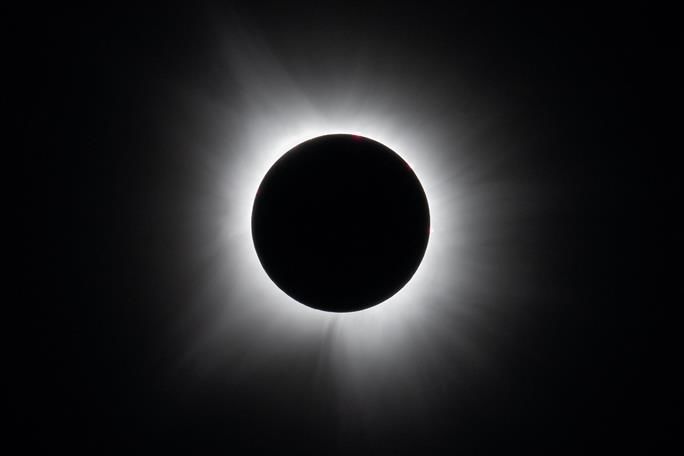North Americans rejoice in the solar eclipse with drinks, music, and marriage
As the sun dipped below the horizon on Monday, thousands of skywatchers throughout North America rejoiced and celebrated the first complete solar eclipse to cover the continent in seven years with drinks, music, and marriage.

Spellbound audiences responded to the sight of “totality” with jaw-dropping sentiments of astonishment and excitement from a Mexican beach resort near where the eclipse made landfall to the banks of the Ohio River and further north beyond the thundering cascades of Niagara Falls at the US-Canadian border.
Near the lone nuclear power plant in the state, Russellville, Arkansas, is home to around 30,000 people. around 400 couples were married in the moon’s shadow during a large-scale event called “Elope and the Eclipse.” Despite cloudy skies, at least two marriages and one marriage proposal were believed to have occurred among the approximately 2,000 individuals that gathered at Niagara Falls State Park.
The experience was muted by the gloomy weather until the final 30 seconds of totality were shown by temporarily separated clouds, to which the audience erupted in cheers and exclamations of “It’s so beautiful.”
A band performed a version of R.E.M.’s 1992 hit song “Man on the Moon” as the moon shadow started to recede and the sky brightened once again.
309 individuals, some of whom traveled from as far away as Singapore and London, arrived across the river in Niagara Falls, Ontario, dressed as the sun, creating a new record for the biggest collection of people wearing solar costumes in one location, according to contest organizers. 287 competitors in China set the previous record in 2020.
LUMINANCE AND SHADE
In areas with clear skies, those who saw the eclipse directly were treated to the unique sight of the moon emerging before the sun as a black sphere that momentarily obscured everything save for a magnificent halo of light around the sun’s periphery, known as the corona. (Live coverage by Reuters) It will be the last total eclipse that can be seen from the contiguous United States until 2044, and it was the first to cover a significant portion of North America since 2017.
At a campsite in North Hudson, upstate New York, hundreds of people erupted in delight as totality took place.
Some exclaimed, “Oh my God!” when the air began to chill and a neighboring building’s automated outside lights began to flicker on due to the darkness.
The first significant location to see the complete eclipse was Mazatlan, a coastal vacation town in Mexico. As the sky became darker due to the advancing moon shadow, thousands of people wearing solar-safe glasses relaxed on deck chairs along the waterfront promenade while an orchestra sang the “Star Wars” movie theme.
The moment the eclipse reached totality, the audience erupted into yells, whistles, and applause.
There were many more unsettling eclipse phenomena that heralded the moment of totality, which may last up to 4-1/2 minutes depending on the observer’s position. Midday saw a few stars pop as twilight suddenly dropped, causing the temperature to drop and for a few “shadow bands” to flash across the sky. Occasionally, birds and other creatures become still and quiet.
Eclipse enthusiasts travelled from far and wide in the hopes of seeing the phenomena anywhere along the 4,000 km (2,500 mi) “path of totality,” which ran from the Pacific Coast of Mexico through Texas, 14 other U.S. states, and into Canada. In Newfoundland, the moon’s shadow left continental North America.
When the weather allowed, most of the continental United States outside the line of totality saw a partial eclipse, in which the moon merely covers a piece of the sun.
Lourdes Corro, 43, said she drove 10 hours to go to Mazatlan, Mexico, for an occasion that is regarded as one of the greatest natural marvels of the world.
“The last one I saw was when I was 9 years old,” Corro said.
“There are a few clouds but we can still see the sun.” “UNEQUIvocal SENSORY EXPERIENCE”
A further issue for many was the cloud cover that covered a large portion of the United States.
The pair from Denver, Laura and Brian Uzzle, had originally planned to see the eclipse from Texas, but due to overcast predictions, they had to cancel their plans and book last-minute flights and rental cars several hundred miles (km) away. On Monday, they stood on the banks of the Ohio River between Indiana and Kentucky to witness the eclipse.
The 56-year-old Laura Uzzle expressed her excitement about seeing the eclipse from a riverside brimming with insects and birds.
“Even the wildlife undergoes changes,” she said. “It’s a complete sensory experience.”
The state police in Indiana said that it was closing highway rest areas once they were full and that they would remain closed for the duration due to the large number of eclipse enthusiasts using the state’s roads.
The complete eclipse on Monday lasted up to 4 minutes and 28 seconds, longer than the maximum length of the event in 2017, which was up to 2 minutes and 42 seconds. Totalities for solar eclipses may vary from 10 seconds to around 7 and a half minutes, according to NASA.
A line averaging 115 miles (185 km) broad, covering major cities like San Antonio, Austin, and Dallas, Texas; Indianapolis, Indiana; Cleveland, Ohio; Erie, Pennsylvania; and Montreal, Quebec, was traversed by Monday’s complete eclipse, which passed across more densely populated areas than it did seven years ago.
Approximately 32 million Americans reside inside the path of totality, and an additional 5 million people are expected to visit there, according to federal authorities.
From the time the moon initially started to obscure the sun until it reached totality, around 80 minutes passed, and then it took a another 80 minutes to finish the opposite process.
There is a “diamond ring effect,” when a single bright point glares from one side of the lunar shadow while the sun’s corona still encircles the remaining part of the moon, caused by the final piece of dazzling sunlight before totality.
Some speculated that the encounter would, if only momentarily, have an impact on people’s social behavior.
In Burlington, Vermont, hundreds of tourists created the atmosphere of a midsummer carnival, according to Mayor Emma Mulvaney-Stanak, where hotels were reserved months in advance.
The atmosphere was quite laid back. After being sworn in on April 1, Mulvaney-Stanak told reporters, “People were appreciating the momentousness of the occasion.”
When asked whether she thought the shared experience may help mend some of the political and social conflicts that have been festering in society, the mayor said, “I really think it will.” “Truly, this felt like another huge surge of optimism,” she said.







